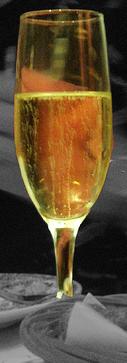Cava (Spanish wine)

Cava (Catalan:
Marketing cava as "Spanish champagne" is no longer permitted under
The word champán in Spanish is not to be confused with achampañado, a colloquial term for the non-traditional sparkling wines. These achampañados wines are generally cheaper, are served by the bottle at bars or restaurants specializing in them and hence these establishments are called by the same name, i.e. achampañado. This is not cava, but it is a somewhat popular drink as well.
Name

The
History
Catalan sparkling wine was first made as early as 1851,[5] while the roots of the cava industry can be traced back to Josep Raventós's travels through Europe in the 1860s, where he was promoting the still wines of the Codorníu Winery. His visits to the Champagne wine region sparked an interest in the potential of a Spanish wine made using the same traditional method. He created his first sparkler in 1872, after the vineyards of Penedès were devastated by the phylloxera plague, and the predominantly red vines were being replaced by large numbers of vines producing white grapes.
Catalan cava producers pioneered a significant technological development in
Production


According to Spanish law, cava may be produced in
To make
References
- ^ ISBN 1-56305-434-5
- ^ ISBN 0-19-860990-6
- ^ a b "RELACIÓN EMPRESAS ELABORADORAS DE CAVA - 2015" (PDF) (in Spanish). DO Cava. Retrieved 30 December 2015.
- ^ "PLIEGO DE CONDICIONES DENOMINACIÓN DE ORIGEN PROTEGIDA "CAVA" - 2011" (PDF) (in Spanish). Consejo Regulador Cava. Archived from the original (PDF) on 13 July 2019. Retrieved 29 June 2017.
- ISBN 0-7566-1324-8
- ISBN 1-84000-332-4
- ISBN 978-1-032-63696-2, retrieved 17 May 2024


